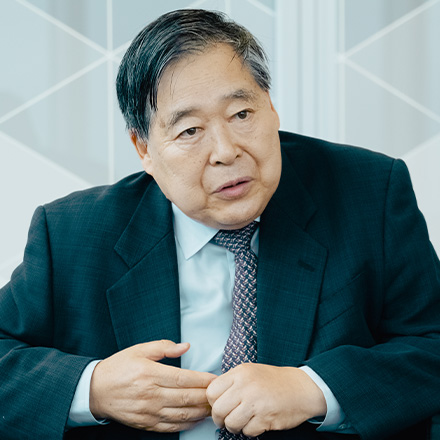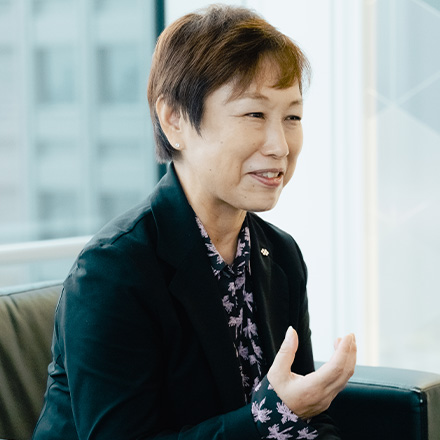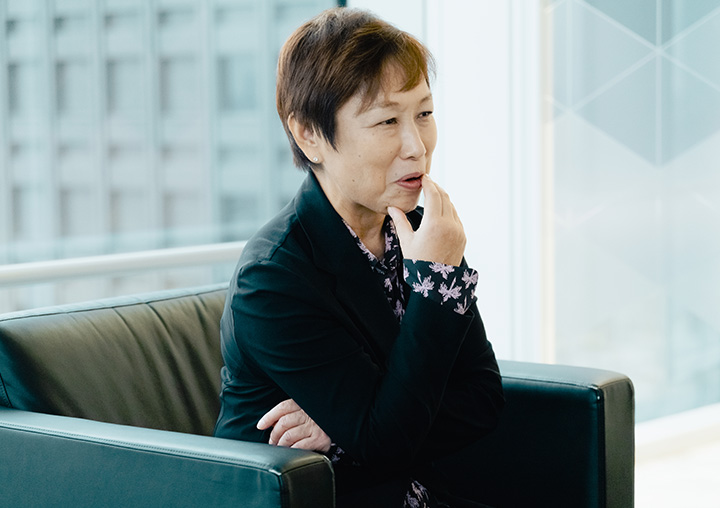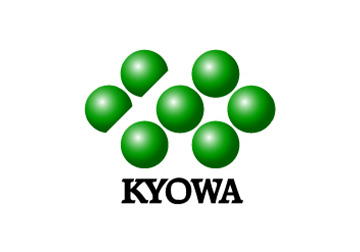Nothing is Wasted in Fermentation. Great Taste and Future Possibilities in the Power of FermentationTakeo Koizumi, Fermentation Scholar and Food Culture Theorist
Yuki Kanzaki, Director of the Board and President & Chief Executive Officer, KYOWA HAKKO BIO CO., LTD.
< Part One >
The keyword "fermentation" is getting more and more attention in recent years. With the help of microorganisms, food keeps better and tastes much nicer. Not only that, but microorganisms are also indispensable for the achievement of a healthy and sustainable society, and they continue to play an unseen role in various aspects of our lives.
Takeo Koizumi, a fermentation scholar and food culture theorist who has researched fermentation for many years and has developed a deep knowledge of the greatness and wonder of fermentation, and Yuki Kanzaki, Director of the Board and President & Chief Executive Officer of KYOWA HAKKO BIO CO., LTD. (Kyowa Hakko Bio), who is pursuing the potential of fermentation in the field of health science, discussed this “hidden power.”
In part one, we take a fresh look at Japan as the land of fermentation, and explore the reality of the amazing culture of fermentation that has spread throughout Japan and the world.

Takeo Koizumi
Fermentation Scholar and Food Culture Theorist
Born in 1943 to a family of sake brewers in Fukushima Prefecture. He is a professor emeritus at Tokyo University of Agriculture. Ph.D. in agricultural studies. He specializes in food culture theory, as well as the study of fermentation and brewing. At present, he is a visiting professor at Kagoshima University, Fukushima University, Beppu University, Ishikawa Prefectural University, Miyagi University, and others, as well as the Head of the School of Fermentation and Sommelier Course for Fermented Foods.
He has written more than 148 books, including "Shoku Areba Raku Ari (translation: Food is Comfort)" (Nikkei), "Hakko Shokuhin Raisan (translation: In Praise of Fermented Food)” (Bunshun Shinsho), "Shoku to Nihonjin no Chie (translation: Food and the Wisdom of the Japanese)" (Iwanami Gendai Bunko), "Shoku no Sekai Isan (translation: World Heritage of Food)" (Kodansha), "Edo no Kenko Shoku (translation: The Healthy Food of Edo)" (Kawade Shobo Shinsha), "Shoyu, Miso, Su wa Sugoi (translation: Shoyu, Miso, and Vinegar are Amazing)" (Chuko Shinsho), and "Chounoryoku Biseibutsu (translation: Microorganisms with Superpowers)” (Bunshun Shinsho). He has also been publishing a serialized work, "Shoku Areba Raku Ari (Food is Comfort)," in the Nihon Keizai Shimbun for 29 consecutive years.

Yuki Kanzaki
Director of the Board and President & Chief Executive Officer, Kyowa Hakko Bio Co., Ltd.
Born in 1963. After completing graduate school at Saga University in 1988, she joined a manufacturer of in-vitro diagnostic agents. In 1992, she joined Kirin Brewery Company, Limited (Kirin Brewery). After serving as Brewing Manager of Kirin Brewery Tochigi in 2007, she served as Deputy General Manager of the Alcoholic Beverage Technology Research Institute, R&D Division at Kirin Company, Limited in 2013, General Manager of Kirin Brewery Kobe in 2015, Executive Officer and General Manager of Kirin Brewery Yokohama in 2017, and Managing Executive Officer and General Manager of Kirin Brewery Yokohama in 2019, before serving as Senior Executive Officer and General Manager of the Corporate Planning Department of KYOWA HAKKO BIO CO., LTD. in 2020 and assuming her current position from January 2022.
Contents
- "Fermentation,” Which Benefits Humans, and "Rotting," Which Causes Harm
- Japan as the Land of Fermentation. Why are We So Good at “Fermentation”?
- Necessity is the Mother of Invention. Unique Fermented Foods From Around the World
- Unusual Alcohol in China. Experience Healthy Alcohol that Gives Your Body a Fragrance
- Nothing is Wasted in Fermentation. Ecological Systems that Support a Sustainable Society
"Fermentation,” Which Benefits Humans, and "Rotting," Which Causes Harm

Q: Fermentation has been attracting more and more attention in recent years. Today, I would like you to talk about its appeal and potential.
Koizumi:These days, people of all ages, from the young to the elderly, are very interested in fermentation. In that sense, it is no longer a boom. It has become completely established and now feels like a part of day-to-day life.
Kanzaki:I would like to ask you, Dr. Koizumi, as a legend of the study of fermentation, to go over "what fermentation is" again.
Koizumi:There are often people who say that fermentation means something is "rotten," but it is completely the opposite. Both fermentation and rotting are the work of invisible creatures, i.e., microorganisms, but fermentation does something very good job for us as humans. For example, if we talk in terms of good bacteria and bad bacteria, you can think of fermentation as the former.
The natto bacteria causes natto to ferment, acetic bacteria causes vinegar to ferment, yeast causes bread to ferment and makes alcohol, and lactic acid bacteria makes yogurt, cheese, and even pickles. In other words, fermentation is useful and beneficial for humans, and we refer to the microorganisms that control it as fermentative bacteria. On the other hand, pathogenic bacteria and putrefactive bacteria are what cause harm such as stomach upsets and illness.
Next, and I think this is something we should be proud of, Japan is a country that has foresight in relation to fermentation, and has amazing technical skill in this area. Even beer was originally drank in Europe, but after it came to Japan, we made it completely our own thing. I think Japanese beer is really the best in the world. Furthermore, our wine and whiskey have both established positions of global renown. These days, I live in Hokkaido about half the time, and the cheese in Nakashibetsu (a place in Hokkaido) is as good as that from the home of cheese, France. I think fermentation is really the best industry for Japan.
Japan as the Land of Fermentation. Why are We So Good at “Fermentation”?

Q: Why is fermentation flourishing so much in Japan?
Koizumi:Perhaps because we have a history of fermentation in Japan. From the latter half of the Heian period (ninth to twelfth centuries) to the Muromachi period (fourteenth to sixteenth centuries), people cultivated invisible koji mold spores and there were businesses making the starters needed to make miso, soy sauce, sake, and other products to sell to miso and sake sellers. Moreover, just soy sauce alone has a very diverse history of craftsmanship. The most popular types of sauce today are soy sauce made from soy beans and fish sauce made from fish, but in the Nara period (eighth century), there was also “meat sauce” made from chicken, animal meat, etc., and “grass sauce” made from vegetables.
Kanzaki:What was behind such diverse fermentation practices?
Koizumi:First of all, there was the climate and land. Japan is very humid, so food must be preserved. Japan is also an island country completely surrounded by the sea. In other words, it is rich in salt. Salt has the effect of suppressing bacteria and mold that cause things to rot. That is why there are many salty fermented foods made with salt in Japan. The reason why fermentation culture has advanced so much in Japan is largely due to geography.
Kanzaki:It seems like there is also something like the high extent to which people want their food to taste good. Would you not agree that fermented food is very delicious? These tastes definitely cannot be made just with salt. Salted koji was popular long ago, but salt and salted koji have completely different flavors. In the case of soy sauce too, we do not use it just to add a salty taste to food. Fermentation causes amino acids and umami flavor to condense and produce an undeniable great flavor. We want “that flavor.” Once people taste it, they are no longer satisfied with other salty tastes. I used to be the General Manager of a brewery at Kirin Brewery, and fermentation is necessary to achieve that complex umami flavor of beer.
Koizumi:You're absolutely right.
Kanzaki:Sometimes people ask whether, if we know the ingredients, we can make similar-tasting beer by mixing them, but it is impossible to achieve that complex balance of flavors without microorganisms. Japanese people have long been exposed to the great taste of fermentation, so we probably have discriminating palates. It is not enough for us if food is only a little delicious. I think this large extent to which we require great flavor has created this rich fermentation culture.
Q: In simple terms, I think it is amazing that we have control over these invisible things.
Koizumi:That is true. We use invisible microorganisms as though we have domesticated them. It is like a gift of imagination, ideas, and execution. For example, both the natto bacteria and lactic acid bacteria are about 0.4 microns in size. One micron is 1/1000 of one millimeter. These tiny creatures take nutrients into their bodies, metabolize them, and spit them out. In other words, they use their bodies, which are 0.4 microns in size, to do almost exactly what we humans do when we live and give birth to children. I am amazed at the strength of their vitality.

Necessity is the Mother of Invention. Unique Fermented Foods From Around the World

Kanzaki:Dr. Koizumi, you eat various unique fermented foods from all over the world.
Koizumi:Japanese fermented foods are interesting, but when you look at the rest of the world, there are many interesting things. The more you eat, the more you realize the richness of fermentation culture. When I was teaching at the Tokyo University of Agriculture, I was seconded to the National Museum of Ethnology as a joint researcher for about seven years. There, I researched the relationships between foods and ethnic groups, and between types of alcohol and ethnic groups. I was mainly looking at the Mekong Delta in Southeast Asia, where there was a lot of fermented foods. I was especially surprised by the soy sauce made with insects. They use crickets and silkworm pupae as ingredients.
Kanzaki:Insects are a rich source of nutrition. Eating insects has also been attracting attention as a means of preparing for an era of food crisis.
Koizumi:The most amazing example was soy sauce made from giant water bugs, mainly in northern Thailand. Anyway, the smell is amazing. I like it so much that I always buy it whenever I go to Thailand on business. Previously, when I gave it to my friend, cartoonist and essayist Sadao Shoji, he was surprised when he smelled it and said “wow!” It smells really great, like La France pears.

Kanzaki:Soy sauce made with giant water bugs...! And La France pears? I can't imagine.
Koizumi:I wondered why it smelled like it did, even though it is just giant water bugs steamed, mashed, and pickled in salt, but then one time, I found out the cause. There is a world-famous insectology professor named Yasuaki Watanabe at the Tokyo University of Agriculture, and when I went to ask him, he told me that this was the pheromone of giant water bugs.
The most unusual and strange dish I've ever had, however, was “Kiviak,” made by Inuit people, which I ate in Greenland. You put about 300 auk birds with their wings still attached into the belly of a seal, bury it completely in the ground and let it ferment for about three years. Then, you take out the birds from inside and suck out the fermented fluid through the anus. The reason they eat such a thing is because the area where they live is covered by permafrost. In other words, they cannot harvest vegetables and fruits. I once took Kiviak home and analyzed its constituents, and it had vitamins B1, B2, and B6... all the nutrients that humans need.
Kanzaki:In other words, they made up for nutrients that they lacked by fermenting ingredients they had easy access to.
Koizumi:That's right. Unconsciously, they used fermentation to make what their bodies required. All fermented foods are born in a way that reminds me of the phrase "necessity is the mother of invention." In the villages along the Mekong River, for example, most households still do not have refrigerators, so even if people catch a lot of fish, it will rot if they do not do something with it. Therefore, they ferment it and preserve it. In Japan, too, distribution networks were not sufficient in the countryside in the past, so people struggled to get enough food and vitamins in winter. Fermentation has provided a solution to these inconvenient lifestyles.
Kanzaki:It is a kind of “wisdom” to help people live in places where it is difficult to live. We lead comfortable lives now, but we may not be able to live as we do now if environmental problems become more serious. At Kyowa Hakko Bio, we feel that fermentation has great potential to help us overcome the difficult situation that we will face in the future.
Unusual Alcohol in China. Experience Healthy Alcohol that Gives Your Body a Fragrance

Koizumi:This conversation will appear in Kirin's media, right? In that case, I want to talk about alcohol. The most unusual alcohol I've ever had was “mandian xiangjiu” (Anglicized) in Guiyang, Guizhou, China.
Kanzaki:Does "xiangjiu" (translation: fragrant wine) mean that there is something characteristic about the fragrance?
Koizumi:In terms of what it is, it is so-called “baijiu,” or what we call shochu in Japan. It is a kind of distilled liquor made from kaoliang, corn, and other ingredients. It has a high alcohol content of around 50% on average. In Japan, Shaoxing rice wine is a popular kind of Chinese alcohol, but in fact, baijiu is more widely drunk in China.
Kanzaki:The way baijiu is made is also very interesting. Most alcoholic beverages, such as whiskey and shochu, are fermented and distilled in liquid form, but baijiu is fermented as a solid. In other words, baijiu is a rare kind of alcohol in which the ingredients are steamed, mixed with koji, and fermented as a solid, then the whole mass is distilled. That's why the alcohol content is so high. When we go on business trips to China, we end up drinking baijiu at night, but people are shocked by the high alcohol content (laughs). Compared with beer, however, it smells like it was fermented without enough oxygen. A smell like apples, of caproic acid.
Koizumi:I understand. I also feel isovaleric acid. ...well, we have ended up talking somewhat in jargon (laughs). Mandian xiangjiu, however, is not ordinary baijiu. This is a rare kind of baijiu that was made 100 years ago by soaking 87 kinds of incense, such as sandalwood and musk, for about five years. Of course it was expensive, so only the aristocracy could drink it at that time. I happened to find some left in a storehouse at a brewery in Guizhou. It was a surprising drink. At that time, the president of the brewery also showed me the reference room, and this alcohol appeared in a book called "A History of Famous Alcoholic Beverages in China. (translation)” When I read it, it said that when you drink mandian xiangjiu, the fragrance comes out of your body, and it also acts as a medicine for all kinds of diseases. This alcohol had an amazing concept behind it, of removing evil by putting incense in the body.
By the way, they gave me about 50cc as a token of friendship between Japan and China, which I drank in the hotel room with the director of the brewing laboratory, Mr. Meiji Suzuki, who accompanied me on the trip. I remember vividly the next morning, when, surprisingly, the smell of incense came from our urine! We each became excited the next morning, saying, "there's a nice smell coming from the toilet!" and "my urine also smells good!"
Nothing is Wasted in Fermentation. Ecological Systems that Support a Sustainable Society

Q: What a great story (laughs). Ms. Kanzaki, you originally joined Kirin Brewery Company and were then transferred to Kyowa Hakko Bio. What does “fermentation” mean for Kirin Brewery and Kyowa Hakko Bio?
Kanzaki:I was originally the General Manager of a brewery at Kirin Brewery, then I moved to Kyowa Hakko Bio, a group company, and now I am involved in the Health Science business. As shown by the fact that “Hakko” (fermentation) is in the name of the company, fermentation is involved in every process of our businesses. When I took another look, I was really surprised, exclaiming “that’s fermentation too!" We use fermentation not just to make things, but also for technology to dispose of waste generated in the process. In other words, we are always relying on microorganisms, from beginning to end.
The same also applies with beer. In the past, we used to use aerobic treatments on barley pomace and wastewater generated when we made beer. In other words, this meant using aerobic microorganisms, which require oxygen, for decomposition, but we have now adopted anaerobic treatment, in which anaerobic microorganisms, which do not require oxygen, process the barley pomace and wastewater. The latter does not require any aeration (oxygen), so we can expect to save energy. In general, chemical reactions based on synthesis, etc., require enormous amounts of energy and large-scale facilities, but with the help of enzymes and microorganisms, they are surprisingly easy and also inexpensive.
Koizumi:There is really no waste when using microorganisms. This is very important, because it means that we can use fermentation on things that would rot if left alone to preserve them and make them taste good, creating a positive result instead of generating waste.
I mentioned earlier that I live in Sapporo, but I also work there as an advisor for a marine products company. This company was having trouble dealing with the internal organs left over when making processed foods from salmon. When they consulted me, I suggested making soy sauce with those internal organs. So, we bought designs and tried making it, and successfully created a very delicious soy sauce. It is sold under the product name "Sake Shoyu (translation: Salmon Soy Sauce)," and is very popular. In addition, a product called "Ishikari Ramen" was also created using this soy sauce. Waste that used to cost tens of millions of yen to dispose of has become a profit-generating product, so there really is a wide variety of microorganisms.
Kanzaki:Kyowa Hakko Bio's goal is to create a sustainable society and produce products in ways that have less impact on the environment, but neither the health food we produce nor Kirin's beer could be made without fermentation. Fermentation is, after all, an ecological system. In other words, we were made aware that we had been unconsciously putting the SDGs into practice through our work and manufacturing. I am very happy that our day-to-day work directly contributes to the “natural environment.”
Release date: November 24, 2022
* The content, affiliations, titles, etc., are as of the time of release.
- Photography:Yuji Ueno
- Text:Chikara Tsujimoto
- Editing:RIDE Inc.





